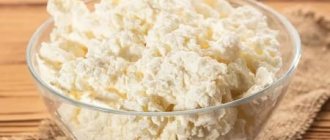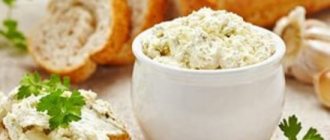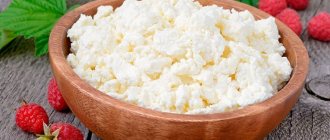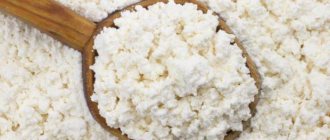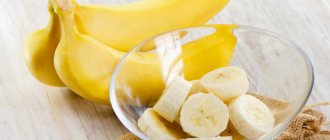The benefits and harms of dairy products
The characteristic features of natural dairy products are their benefits for well-being. They include vitamins and minerals that are required for human development:
- calcium;
- phosphorus;
- potassium;
- amino acids;
- proteins;
- vitamins: B12, A, D.
Cheese, yogurt along with milk will benefit teeth, bones, and joints. The benefits of fresh milk products include fighting free radicals, reducing radiation, and removing toxins and heavy metals.
High-quality cheese eliminates nervous tension and anxiety. Nutritionists advise not to give up a piece of cheese before bed.
Ryazhenka and kefir are useful for gastrointestinal dysfunction. Kefir grains are responsible for restoring intestinal microflora. Strengthen the immune system, resist dysbacteriosis, fight insomnia and constant fatigue.
Sour cream is rich in vitamins: A, B2, E, B12, PP, C, which are required for the skeleton and esophagus. The increased content of calcium, sodium, phosphorus, copper, zinc and magnesium in the structure of cottage cheese has a beneficial effect on the functioning of the brain. Cottage cheese will benefit older people.
Butter contains many proteins, vitamins and minerals. The product stabilizes the activity of the central nervous system and brain. However, caloric content affects the consumption of sour cream.
Why are dairy products harmful? Dairy products can cause harm if they are made from unnatural raw materials and include preservatives.
Sometimes milk is the cause of individual intolerance or an allergic reaction. During pasteurization, milk loses its usefulness: calcium and protein are destroyed. Heat-treated yoghurts with fillers have reduced biological value.
The accumulation of casein from sour cream or cottage cheese causes food to stick together and be difficult to process.
The frequency of consumption of unnatural milk products is fraught with harm to humans: persistent fatigue, headaches, bloating, diarrhea, vascular congestion, degeneration of articular cartilage and atherosclerosis.
Kumis
This ancient fermented milk drink is made exclusively from mare's milk, fermented with special starter cultures.
Asian nomadic peoples (Scythians, Tatars, Mongols, Bashkirs, Kazakhs, Kyrgyz, Turkmens, Kalmyks) have been preparing it since time immemorial, knowing its excellent taste properties and healing effects on the human body.
Such tribes did not raise livestock because they did not have a permanent place of “residence.” On endless campaigns and movements, their faithful companions were horses, which were used both as transport and as food.
Fresh mare's milk tastes unpleasant and spoils very quickly, but in the form of a fermented milk drink it acquires a lot of useful qualities and the ability to be stored for a long time.
Later, some peoples began to make kumis from the milk of camels and cows, but the traditional drink is based on mare’s milk.
Classification of dairy products
Consumers are wondering what applies to dairy products? According to the classification, milk products are divided into several groups:
- Fermented dairy products. Another name is fermented milk. Cottage cheese and kumiss, curdled milk and yogurt, sour cream and kefir, ayran, fermented baked milk and shubat, cheese include lactic acid bacteria. Gram-positive microaerophilic microorganisms normalize intestinal flora and eliminate dysbiosis.
- Separation products. The category includes cream, whey, butter. The serum is suitable for strengthening the immune system, improving digestion, normalizing weight, and removing excess cholesterol. Fats are responsible for supplying the body with bioenergy and protecting against hypothermia. Separation products ensure the preservation of milk properties.
- High-tech milk products. This includes ice cream, milk: baked, dry, pasteurized, condensed. Will not bring significant benefit.
All types of dairy products, with the exception of high-tech dairy products, include nutrients. Minerals, vitamins, BJU are easily digested and support human life.
Attention! Milk is classified as a perishable product; it is stored in a cool place at t=+5 °C. If the packaging is opened, the shelf life of the product is limited to 2 days.
Varenets to strengthen the immune system
This fermented milk product is similar in preparation technology to fermented baked milk, but is still slightly different from it. Varenets is simmered in a stove or oven at a higher temperature, and fermented not only with sour cream, but also with cream. In Ural and Siberian cuisine, Varents was baked milk seasoned exclusively with cream.
Varenets and fermented baked milk are equally useful - they boost immunity and improve food digestion. In addition, Varenets strengthens heart and muscle tissue, alleviates chronic pancreatitis and prevents the development of osteoporosis.
Homemade Varenets can be stored for five days in the refrigerator, but store-bought Varenets does not spoil much longer. Typically, shelf life is indicated on the packaging.
Try making Varenets parfait - this is a wonderful dessert for those who watch their diet. Beat 100 g banana with 1 tbsp in a blender. l. honey and a glass of Varents. When the volume increases, pour the mixture into molds and place in the freezer for 3 hours. Garnish the parfait with fresh raspberries, add some granola and serve as a healthy dessert.
List of dairy products
Ayran
The drink has been in demand in Central Asia for thousands of years. The starting material for ayran is cow's or goat's milk, into which salt, yeast, and water are mixed. Add basil. The drink resembles liquid salted kefir.
For centuries, mountain people valued ayran and kept the recipe for longevity. In Armenia, the drink that is prepared without basil is called tan. The product is suitable to quench thirst, stabilize the stomach, and strengthen blood vessels.
Bifilife
Belongs to the new generation of fermented dairy products. It is similar to kefir, but it has a richer composition:
- bifidobacteria: 5 species;
- leaven;
- whole cow's milk.
A mixture of skimmed and whole milk provides the required fat content: 3.2 or 2.5%. The calorie content of 100 g of the healthiest dairy product is 56 kcal. The thoughtful composition normalizes metabolism and cholesterol levels, restores intestinal flora, and fights gastritis.
The bifilife product is not an obstacle for simultaneous use with antibiotics. In case of some problems, it will replace expensive medications from the pharmacy.
Bifilife is produced for baby food starting from 8 months of age. Classic bifilife is recommended for children from 3 years old.
Varenets
This is an old recipe for a Siberian fermented drink. The manufacturing technology involves simmering milk in an oven in a clay pot, evaporating by 1/3 or more, lowering the creamy foam to the bottom. Sourdough - sour cream or cream is added to the thickened mass. Varenets was served for tea.
At home, they use a multicooker with the “stewing” mode set. Milk is poured into a bowl. After 5 hours, cool and pour into a clay container. Leave in a warm place for a couple of hours. For half a liter of baked product, take 100 g of sour cream.
Yogurt
We are talking about an excellent fermented product if it contains natural ingredients. When fermenting yogurt, a Bulgarian stick is required. Common fermented milk products strengthen the immune system and stabilize the intestinal microflora. Regular consumption of yogurt reduces cholesterol levels, improves brain function, improves concentration and visual perception.
When is the best time to eat cottage cheese?
According to scientific research, calcium from cottage cheese is best absorbed in the evening and at night. But there are some nuances here too. In low-fat cottage cheese the insulin index is high, and in fat cottage cheese it is low.
At night, it is better to eat foods with a low insulin index, because high insulin levels block the production of another very important hormone - somatotropin (growth hormone) - at night. And even if you no longer need to grow, growth hormone stimulates the development of muscle mass and at the same time promotes the utilization of fat tissue. This is the most powerful fat burning hormone. And if you eat something that significantly increases the level of insulin in the blood, insulin will block the production of growth hormone.
If you eat natural fat cottage cheese to improve calcium absorption, it is better to do this during an afternoon snack or dinner.
And if you monitor your blood sugar levels, carbohydrate metabolism and insulin levels, it is better to postpone the consumption of cottage cheese to the first half of the day.
There is no need to eat more than 100-150 grams of cheese at a time, because the body can absorb no more than 35 grams of pure protein, which corresponds to 100-150 grams of the finished product.
Calorie table for dairy products
Dairy products are varied - from widespread to local dishes. In order not to harm your health, it is important to listen to your body. Natural products that do not contain sweeteners or dyes are preferable. Remember: everything is good if consumed in moderation.
| Number of calories per 100 g of product (kcal) | Proteins (g) | Fat (g) | Carbohydrates (g) | |
| Milk 1.5% | 44 | 2,9 | 1,5 | 4,7 |
| Milk 2.5% | 52 | 2,8 | 2,5 | 4,7 |
| Milk 3.2% | 58 | 2,9 | 3,2 | 4,7 |
| Country milk | 64 | 2,95 | 3,6 | 4,74 |
| Low-fat kefir | 30 | 3 | 3,8 | |
| Kefir 1% | 40 | 3 | 1 | 3,8 |
| Kefir 3.2% | 59 | 3 | 3,2 | 3,8 |
| Ryazhenka 2.5% | 54 | 2,8 | 2,5 | 4,2 |
| Bifidok | 55 | 2,8 | 2,5 | 6 |
| Snowball | 79 | 2,7 | 2,5 | 10,8 |
| Acidophilus 2.5% | 51 | 2,8 | 2,5 | 4,2 |
| Yogurt 2.5% | 53 | 2,9 | 2,5 | 4,1 |
| Sour cream 10% | 115 | 3 | 10 | 2,9 |
| Sour cream 15% | 160 | 2,6 | 15 | 3 |
| Sour cream 25% | 248 | 2,4 | 25 | 3,2 |
| Country sour cream | 541 | 2,4 | 40 | 2,6 |
| Cream 10% | 118 | 3 | 10 | 4 |
| Cream 20% | 206 | 2,8 | 20 | 3,7 |
| Cream 30% | 287 | 2,2 | 30 | 3,1 |
| Cream 38-40% | 347 | 2,7 | 40 | 4,1 |
| Butter 72.5% | 661 | 0,8 | 72,5 | 1,3 |
| Butter 82% | 748 | 0,7 | 82,1 | 0,7 |
| Country butter | 748 | 0,6 | 85 | 0,7 |
| Milk serum | 18 | 0,8 | 0,2 | 3,5 |
| Drinking yoghurt without taste | 72 | 5 | 3,2 | 3,5 |
| Low-fat cottage cheese | 79 | 16,5 | 1,3 | |
| Cottage cheese 5.9% | 121 | 17,2 | 5,9 | 1,8 |
| Cottage cheese 9% | 159 | 16,7 | 9 | 2 |
| Cottage cheese grain 5% | 105 | 12,7 | 5 | 2,4 |
| Tang | 24 | 1,1 | 1,5 | 1,4 |
| Ayran | 27 | 1,8 | 1,05 | 2,8 |
| Matsoni (from cow's milk) | 54 | 2,8 | 3,2 | 3,6 |
| Kumis | 50 | 2,1 | 1,9 | 5 |
How to make cottage cheese at home
To make homemade cottage cheese, you first need to ferment the fermented milk base and then remove the liquid from it.
You can use animal milk of any fat content. If you are cooking with farm milk or pasteurized milk, it needs to be boiled and cooled to a temperature of 37-40°C. This temperature is slightly warmer than body temperature. But still, for a guaranteed result, it is better to use a kitchen thermometer.
UHT milk does not need to be heat treated if you prepare cottage cheese in a slow cooker or yogurt maker. Before cooking, the pan should be heated to no more than 40°C, but not lower than 37°C, in order to provide bacteria with a favorable environment for their reproduction.
To speed up the process of fermented milk fermentation and prepare cottage cheese with minimal effort and time, we recommend using a ready-made bacteria complex, which is available in two versions:
- VIVO cottage cheese in bags;
- VIVO cottage cheese in bottles.
One jar or bag of starter can ferment 1-3 liters of milk. For the first stage of preparation, you can use any available utensils or equipment: a saucepan, a slow cooker or a yogurt maker. And for straining the whey, a thin filtration material is suitable: gauze folded in several layers, a cotton towel or a fine sieve. The longer you leave the grains to strain, the more moisture they will release and the drier the product will be.
In a saucepan
Before starting cooking, rinse the pan with boiling water to remove unnecessary microflora.
- Pour the milk into the pan and heat to a temperature of +37..+40.
- You can use a kitchen or household body thermometer to monitor the temperature. If you don’t have such a device at hand, drop some milk on your wrist; it should be a little warmer than your body.
- Add warm milk to the bottle with the starter, close the lid and stir. Then return to the pan. The powder from the bag can be added to the entire volume of liquid at once.
- Stir the milk with a spoon to evenly distribute the bacterial culture. Cover the pan with a lid.
- Wrap the pan in a warm blanket or towel. In this mode, the milk will ferment for 6 to 8 hours, depending on the temperature. You can safely leave it overnight. And if the kitchen is too cold, place the bundle near a heat source.
- When the finished product thickens after the specified time, it should be placed in the refrigerator for 2-3 hours.
- Return the pan to the stove and slowly heat the mixture to a temperature of 85-90°C. Heat the milk over low heat, without bringing it to a boil.
- As a result, the curd lumps and liquid should separate. This takes on average about 50 minutes.
- Then turn off the heat and leave to cool.
- Transfer the mixture to cheesecloth, folded in 3-4 layers, and hang to remove the whey. Be sure to place a large bowl under the lump to catch the liquid.
In the yogurt maker
The rules for preparing milk are the same as for a multicooker. The indisputable advantage of this method is its simplicity: the starter can be added directly to milk at room temperature, mixed and cooked in the same container. This way you can prepare fermented milk products in the VIVO YOGOBOX yogurt maker. There are only two buttons on the panel: “Kefir” and “Yoghurt”, and to prepare cottage cheese you will need the “Yoghurt” option - the device will do the rest, and you will receive the finished product in 8 hours.
For cooking in other devices:
- Mix the milk with the starter.
- Pour into cups of yogurt maker or pour into the bowl of the device, cover with lids.
- Depending on the power of the device, expect from 6 to 8 hours.
- After completing the program, it is advisable to cool the product for several hours in the refrigerator.
- When the mixture has settled, pour it into a saucepan and heat on the stove to 85-90°C over low heat.
- After 40-50 minutes, the curd flakes will begin to gather, then you can remove from the heat and cool the mixture.
- Pour the ingredients into a fine sieve, but make sure no grains fall out. Strain the product to the desired state.
In a slow cooker
The multicooker must have the “Yoghurt” option or a manual temperature adjustment mode: “Multicook” or “40 degrees”. You choose the fermentation method yourself - in the container of the device or in portioned jars.
- If you need to boil homemade or pasteurized milk, it is convenient to use the “Boiling” mode for 15-20 minutes, and then wait for it to cool.
- In the case of ultra-pasteurized, it is enough to take it out of the refrigerator in advance so that it is not too cold. Pour it into the bowl and add dry bacterial starter, stir.
- If you cook in portioned jars, combine the milk and bacteria in a separate container, mix and pour into individual containers. Cover with lids, place in the multicooker bowl and fill with water almost to the very top of the jars.
- Cover the device with a lid, turn on a suitable program and wait 6-8 hours.
- After the ready signal, set the heating mode at 85°C for 45-50 minutes. During this time, the curd flakes should separate.
- Drain into a sieve lined with a kitchen towel and leave over a bowl until all the liquid is gone.
Ryazhenka: creamy tenderness
Ryazhenka is prepared from baked milk, which is fermented with cultures of Bulgarian bacillus or thermophilic lactic acid streptococci. The fermentation process lasts from 3 to 6 hours, after which the product acquires a creamy beige hue and a pleasant taste. Ryazhenka is similar to baked milk, but is absorbed much better. This product was invented by Ukrainians by mixing milk with cream, which was then simmered in an oven and fermented with sour cream. This is where the name ryazhenka came from - from the word “yarn”, that is, to fry. It is recommended to drink it for digestive problems, liver and kidney diseases.



